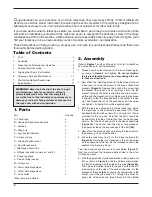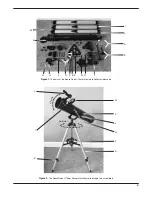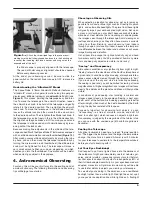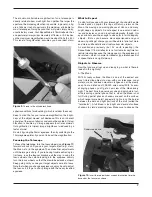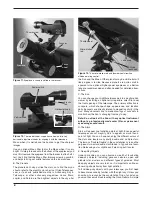
4
castings on the optical tube
(8c). They should be reason-
ably tight but still allow movement of the telescope up and
down with gentle force.
7. Thread the altitude lock knob (J) into its receptacle on the
side of the yoke mount and tighten it
(Figure 9).
8. Install the red dot finder scope (L) on the optical tube. Do
this by orienting the finder scope as shown in
Figure 10
and sliding the bracket foot into the finder scope base until
it clicks. (To remove the finder scope, press the small tab
at the back of the base and slide the bracket out.)
9. Finally, insert the 25mm eyepiece (N) into the focuser (take
the dust cap off the focuser first) and secure it by lightly
tightening the thumbscrew on the focuser
(Figure 11).
The telescope is now completely assembled! Before it can be
effectively used, however, there are a couple of things to do to
prepare the telescope for operation.
3. Preparing the Telescope
for Operation
Aligning and Using the Red Dot Finder Scope
The included red dot finder scope (L)
(Figure 12) makes
pointing your telescope almost as easy as pointing your fin-
ger! It’s a non-magnifying aiming device that superimposes
a tiny LED red dot on the sky, showing exactly where the
telescope is pointed. It permits easy object targeting prior to
observation in the higher-power main telescope.
Before you can use the red dot finder scope, you must remove
the small plastic tab sticking out from the battery compart-
ment
(Figure 12). Doing so will allow the pre-installed 3V
CR-2032 button cell battery to make contact with the finder
scope’s electronic circuitry to power the finder’s red LED illu-
minator. The tab can then be discarded.
To use the red dot finder scope properly, it must be aligned
with the main telescope. This is easiest to do during daylight
hours, before observing at night. Follow this procedure:
1. First, remove the dust cover (M) from the front of the tele-
scope.
2. With the 25mm eyepiece already in the focuser from step
9 above, point the telescope at a well-defined land target
(e.g., the top of a telephone pole) that’s at least a quar-
ter mile away. When pointing the telescope, be sure to
loosen the azimuth lock knob and micro-motion lock knob
(for coarse movement in altitude) to allow the telescope to
rotate freely about both axes.
3. Center the target in the eyepiece.
Note:
The image in the eyepiece will appear rotated or
upside down. This is normal for reflector telescopes, and is
why they are not recommended for daytime terrestrial use.
4. Turn on the red dot finder scope by sliding the power
switch to ON (refer to
Figure 12). The “1” position provides
dim illumination while the “2” position provides brighter illu-
mination. Typically the dimmer setting is used under dark
skies and the brighter setting is used under light-polluted
skies or in daylight. Position your eye at a comfortable dis-
tance from the rear of the unit. Look through the rear of the
finder scope with both eyes open to see the illuminated
red dot. The target object should appear in the field of view
somewhere near the red dot.
5. You’ll want to center the target object on the red dot. To do
so, without moving the telescope, use the finder scope’s
vertical and horizontal adjustment knobs (shown in
Figure
12) to position the red dot on the object.
6. When the red dot is centered on the distant object, check
to make sure the object is still centered in the telescope’s
eyepiece. If it isn’t, re-center it then adjust the finder
scope’s alignment again. When the object is centered in
the telescope eyepiece and on the finder scope’s red dot,
Figure 4.
Attach the tripod leg brace to the bracket on each tripod leg.
Tripod leg
Bracket
Tripod leg brace
Figure 3.
Thread a leg
lock thumbscrew onto
each tripod leg as shown,
being careful not to
overtighten.
Leg lock knob


